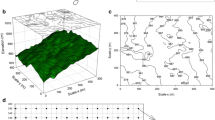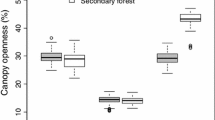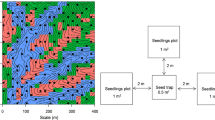Abstract
Seedling dynamics play a crucial role in determining species distributions and coexistence. Exploring causes of variation in seedling dynamics can therefore provide key insights into the factors affecting these phenomena. We examined the relative importance of biotic neighborhood processes and habitat heterogeneity using survival data for 5,827 seedlings in 39 tree and shrub species over 2 years from an old-growth temperate forest in northeastern China. We found significant negative density-dependence effects on survival of tree seedlings, and limited effects of habitat heterogeneity (edaphic and topographic variables) on survival of shrub seedlings. The importance of negative density dependence on young tree seedling survival was replaced by habitat in tree seedlings ≥4 years old. As expected, negative density dependence was more apparent in gravity-dispersed species compared to wind-dispersed and animal-dispersed species. Moreover, we found that a community compensatory trend existed for trees. Therefore, although negative density dependence was not as pervasive as in other forest communities, it is an important mechanism for the maintenance of community diversity in this temperate forest. We conclude that both negative density dependence and habitat heterogeneity drive seedling survival, but their relative importance varies with seedling age classes and species traits.




Similar content being viewed by others
References
Bates D, Maechler M, Bolker B (2010) lme4: Linear mixed-effects models using S4 classes. R Package Version: 0.999375-37 edn
Burnham KP, Anderson DR (2002) Model selection and multimodel inference: a practical information-theoretic approach. Springer, New York
Canham CD, LePage PT, Coates KD (2004) A neighborhood analysis of canopy tree competition: effects of shading versus crowding. Can J For Res 34:778–787
Cavender-Bares J, Kitajima K, Bazzaz FA (2004) Multiple trait associations in relation to habitat differentiation among 17 Floridian oak species. Ecol Monogr 74:635–662
Chen L, Mi XC, Comita LS, Zhang LW, Ren HB, Ma KP (2010) Community-level consequences of density dependence and habitat association in a subtropical broad-leaved forest. Ecol Lett 13:695–704
Chesson P (2000) Mechanisms of maintenance of species diversity. Annu Rev Ecol Syst 31:343–366
Comita LS, Hubbell SP (2009) Local neighborhood and species’ shade tolerance influence survival in a diverse seedling bank. Ecology 90:328–334
Comita LS, Aguilar S, Perez R, Lao S, Hubbell SP (2007a) Patterns of woody plant species abundance and diversity in the seedling layer of a tropical forest. J Veg Sci 18:163–174
Comita LS, Condit R, Hubbell SP (2007b) Developmental changes in habitat associations of tropical trees. J Ecol 95:482–492
Comita LS, Uriarte M, Thompson J, Jonckheere I, Canham CD, Zimmerman JK (2009) Abiotic and biotic drivers of seedling survival in a hurricane-impacted tropical forest. J Ecol 97:1346–1359
Comita LS, Muller-Landau HC, Aguilar S, Hubbell SP (2010) Asymmetric density dependence shapes species abundances in a tropical tree community. Science 329:330–332
Connell JH (1971) On the role of natural enemies in preventing competitive exclusion in some marine animals and in rain forest trees. In: den Boer PJ, Gradwell GR (eds) Dynamics of Populations. Centre for Agricultural Publishing and Documentation, Wageningen, pp 298–312
Connell JH, Tracey JG, Webb LJ (1984) Compensatory recruitment, growth, and mortality as factors maintaining rain forest tree diversity. Ecol Monogr 54:141–164
Gilbert GS, Harms KE, Hamill DN, Hubbell SP (2001) Effects of seedling size, El Nino drought, seedling density, and distance to nearest conspecific adult on 6-year survival of Ocotea whitei seedlings in Panama. Oecologia 127:509–516
Grothendieck G (2010) sqldf: Perform SQL Selects on R Data Frames. 0.3–5 edn
Grubb PJ (1977) Maintenance of species-richness in plant communities-importance of regeneration niche. Biol Rev Camb Philos Soc 52:107–145
Hao ZQ, Zhang J, Song B, Ye J, Li BH (2007) Vertical structure and spatial associations of dominant tree species in an old-growth temperate forest. For Ecol Manag 252:1–11
Hao ZQ, Li BH, Zhang J, Wang XG, Ye J, Yao XL (2008) Broad-leaved Korean pine (Pinus koraiensis) mixed forest plot in Changbaishan (CBS) of China: community composition and structure. Acta Phytoecol Sinica 32:238–250
Harms KE, Condit R, Hubbell SP, Foster RB (2001) Habitat associations of trees and shrubs in a 50-ha neotropical forest plot. J Ecol 89:947–959
He FL, Legendre P, LaFrankie JV (1997) Distribution patterns of tree species in a Malaysian tropical rain forest. J Veg Sci 8:105–114
HilleRisLambers J, Clark JS (2003) Effects of dispersal, shrubs, and density-dependent mortality on seed and seedling distributions in temperate forests. Can J For Res 33:783–795
HilleRisLambers J, Clark JS, Beckage B (2002) Density-dependent mortality and the latitudinal gradient in species diversity. Nature 417:732–735
Hosmer DW, Lemeshow S (2000) Applied logistic regression, 2nd edn. Wiley, New York
Hubbell SP (2001) The unified neural theory of biodiversity and biogeography. Princeton University Press, Princeton
Hubbell SP, Ahumada JA, Condit R, Foster RB (2001) Local neighborhood effects on long-term survival of individual trees in a neotropical forest. Ecol Res 16:859–875
Iida S, Nakashizuka T (1998) Spatial and temporal dispersal of Kalopanax pictus seeds in a temperate deciduous forest, central Japan. Plant Ecol 135:243–248
Janzen DH (1970) Herbivores and the number of tree species in tropical forests. Am Nat 104:501–528
John R et al (2007) Soil nutrients influence spatial distributions of tropical tree species. Proc Nat Acad Sci USA 104:864–869
Kraft NJB, Valencia R, Ackerly DD (2008) Functional traits and niche-based tree community assembly in an Amazonian forest. Science 322:580–582
Kraft NJB et al (2011) Disentangling the drivers of beta diversity along latitudinal and elevational gradients. Science 333:1755–1758
Martínez-Vilalta J, Mencuccini M, Vayreda J, Retana J (2010) Interspecific variation in functional traits, not climatic differences among species ranges, determines demographic rates across 44 temperate and Mediterranean tree species. J Ecol 98:1462–1475
Masaki T, Nakashizuka A (2002) Seedling demography of Swida controversa: effect of light and distance to conspecifics. Ecology 83:3497–3507
McMahon SM, Metcalf CJE, Woodall CW (2011) High-dimensional coexistence of temperate tree species: functional traits, demographic rates, life-history stages, and their physical context. PLoS ONE 6:e16253
Metz MR, Sousa WP, Valencia R (2010) Widespread density-dependent seedling mortality promotes species coexistence in a highly diverse Amazonian rain forest. Ecology 91:3675–3685
Murray KG (1988) Avan seed dispersal of 3 Neotropical gap-dependent plants. Ecol Monogr 58:271–298
Nakashizuka T (2001) Species coexistence in temperate, mixed deciduous forests. Trends Ecol Evol 16:205–210
Packer A, Clay K (2000) Soil pathogens and spatial patterns of seedling mortality in a temperate tree. Nature 404:278–281
Paine CET, Harms KE, Schnitzer SA, Carson WP (2008) Weak competition among tropical tree seedlings: implications for species coexistence. Biotropica 40:432–440
Paine CET et al (2011) Phylogenetic density dependence and environmental filtering predict seedling mortality in a tropical forest. Ecol Lett 15:34–41
Queenborough S, Burslem D, Garwood N, Valencia R (2007a) Habitat niche partitioning by 16 species of Myristicaceae in Amazonian Ecuador. Plant Ecol 192:193–207
Queenborough SA, Burslem D, Garwood NC, Valencia R (2007b) Neighborhood and community interactions determine the spatial pattern of tropical tree seedling survival. Ecology 88:2248–2258
Queenborough SA, Burslem DFRP, Garwood NC, Valencia R (2009) Taxonomic scale-dependence of habitat niche partitioning and biotic neighbourhood on survival of tropical tree seedlings. Proc R Soc Lond B 276:4197–4205
Ramaswami G, Sukumar R (2011) Woody plant seedling distribution under invasive Lantana camara thickets in a dry-forest plot in Mudumalai, southern India. J Trop Ecol 27:365–373
Russo SE, Davies SJ, King DA, Tan S (2005) Soil-related performance variation and distributions of tree species in a Bornean rain forest. J Ecol 93:879–889
Shao GF, Schall P, Weishampel JF (1994) Dynamic simulations of mixed broadleaved-Pinus koraiensis forests in the Changbaishan Biosphere Reserve of China. For Ecol Manag 70:169–181
Shibata M et al (2010) Effects of abiotic and biotic factors and stochasticity on tree regeneration in a temperate forest community. Ecoscience 17:137–145
Stone R (2006) Ecology—a threatened nature reserve breaks down Asian borders. Science 313:1379–1380
Streng DR, Glitzenstein JS, Harcombe PA (1989) Woody seedling dynamics in an east texas floodplain forest. Ecol Monogr 59:177–204
Svenning JC, Fabbro T, Wright SJ (2008) Seedling interactions in a tropical forest in Panama. Oecologia 155:143–150
Tateno R, Takeda H (2003) Forest structure and tree species distribution in relation to topography-mediated heterogeneity of soil nitrogen and light at the forest floor. Ecol Res 18:559–571
Tsujino R, Takafumi H, Agetsuma N, Yumoto T (2006) Variation in tree growth, mortality and recruitment among topographic positions in a warm temperate forest. J Veg Sci 17:281–290
Uriarte M, Canham CD, Thompson J, Zimmerman JK (2004a) A neighborhood analysis of tree growth and survival in a hurricane-driven tropical forest. Ecol Monogr 74:591–614
Uriarte M, Condit R, Canham CD, Hubbell SP (2004b) A spatially explicit model of sapling growth in a tropical forest: does the identity of neighbours matter? J Ecol 92:348–360
Volkov I, Banavar JR, He F, Hubbell SP, Maritan A (2005) Density dependence explains tree species abundance and diversity in tropical forests. Nature 438:658–661
Wang Z, Xu ZB, Li X (1980) The main forest types and their features of community structure in northern slope of Changbai Mountain. Res For Ecosyst 1:25–42
Webb CO, Peart DR (1999) Seedling density dependence promotes coexistence of Bornean rain forest trees. Ecology 80:2006–2017
Webb CO, Gilbert GS, Donoghue MJ (2006) Phylodiversity-dependent seedling mortality, size structure, and disease in a bornean rain forest. Ecology 87:S123–S131
Welden CW, Hewett SW, Hubbell SP, Foster RB (1991) sapling survival, growth, and recruitment: relationship to canopy height in a neotropical forest. Ecology 72:35–50
Wilson BF (1995) Shrub stems: form and function. In: Gerter BL (ed) Plant stems: physiology and functional morphology. Academic, New York, pp 91–102
Winkler M, Hulber K, Hietz P (2005) Effect of canopy position on germination and seedling survival of epiphytic bromeliads in a Mexican humid montane forest. Ann Bot 95:1039–1047
Wright J (2002) Plant diversity in tropical forests: a review of mechanisms of species coexistence. Oecologia 130:1–14
Wright IJ et al (2007) Relationships among ecologically important dimensions of plant trait variation in seven neotropical forests. Ann Bot 99:1003–1015
Yang H, Li D, Wang B, Han J (1985) Distribution patterns of dominant tree species on northern slope of Changbai mountain. Res For Ecosyst 5:1–14
Yuan ZQ et al (2011) Scale specific determinants of tree diversity in an old growth temperate forest in China. Basic Appl Ecol 12:488–495
Zhang J, Hao ZQ, Li BH, Ye J, Wang XG, Yao XL (2008) Composition and seasonal dynamics of seed rain in broad-leaved Korean pine (Pinus koraiensis) mixed forest, Changbai Mountain. Acta Ecol Sinica 28:2445–2454
Acknowledgments
We thank Drs. Liza S. Comita, Fangliang He, Xiangcheng Mi, Luxiang Lin, and Lei Chen, ChiaHao ChangYang for helpful suggestions on data analysis. We thank Drs. Walter P. Carson, Erin Kurten, C. E. Timothy Paine and an anonymous reviewer for critical comments for the manuscript. We also thank Liwei Wang for his field work and data collection. This work is supported by the National Natural Science Foundation of China (No. 31061160188 and No. 31011120470), the Knowledge Innovation Program of the Chinese Academy of Sciences (No. KZCX2-EW-401 and No. KSCX2-EW-Z-5). The publication of this manuscript has been approved by all co-authors.
Author information
Authors and Affiliations
Corresponding author
Additional information
Communicated by Walt Carson.
Electronic supplementary material
Below is the link to the electronic supplementary material.
Rights and permissions
About this article
Cite this article
Bai, X., Queenborough, S.A., Wang, X. et al. Effects of local biotic neighbors and habitat heterogeneity on tree and shrub seedling survival in an old-growth temperate forest. Oecologia 170, 755–765 (2012). https://doi.org/10.1007/s00442-012-2348-2
Received:
Accepted:
Published:
Issue Date:
DOI: https://doi.org/10.1007/s00442-012-2348-2




